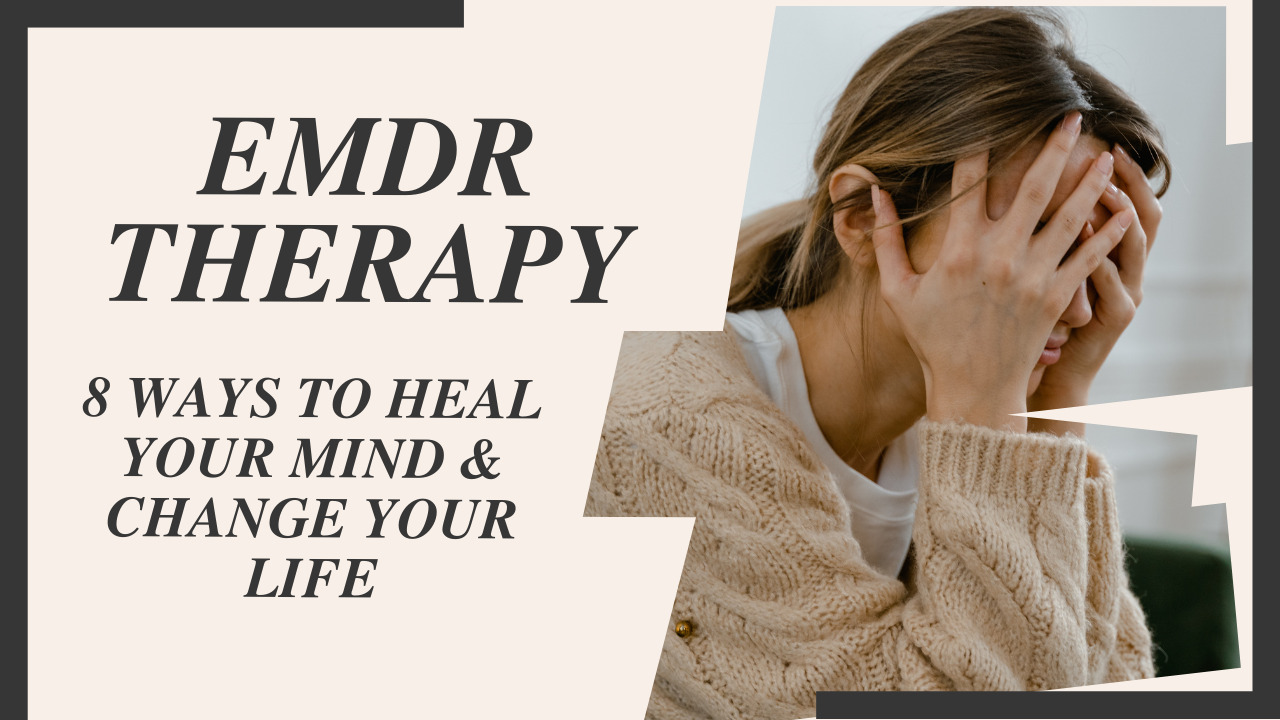EMDR therapy helps you overcome trauma, anxiety, depression, and more. Find out how it can heal your mind & change your life.
Introduction
Sometimes, bad things happen to us that make us feel scared, angry, sad, or ashamed. Are you still haunted by the past and feel like it’s happening all over again? Moreover, you avoid anything that reminds you of bad things, such as people, places, or situations. Do you feel like you don’t care about anything, or you can’t connect with others? Do you have problems with anxiety, depression, fears, or pain?

If your answer is yes to any one of those, you are not alone. A lot of people in the world have problems because of bad things (trauma) that happen to them. These bad things can make it hard for them to do something, get along with others, and be happy.
Bad things can be different for everyone, like being hurt, seeing violence, having an accident, facing a disaster, being in a war, or losing someone. Bad things can also add up over time if you have to deal with them for a long time or many times.
Don’t lose hope. You can get better from trauma and take back your life. There is a therapy called EMDR, which means Eye Movement Desensitization and Reprocessing. EMDR is a way of talking to a therapist who helps you move your eyes or do other things with both sides of your body. This helps you deal with bad memories and feel less upset by them.
How EMDR Therapy Helps
- Make yourself feel better when you are hurt or scared by something that happened to you
- Think good things about yourself and the world instead of bad things
- Learn how to deal with problems and challenges better
- Feel more proud and confident in yourself
- Feel more safe and secure
- Feel more happy and healthy
In this article, I will show you the 8 steps of EMDR and how they can help you feel better and live better. I will also give you some tips and advice on how to get the best out of EMDR and how to keep positive changes and results for a long time. Let’s get started.
Step 1: History and Treatment Planning
You and your therapist need to trust each other and plan what you want to achieve with EMDR. Your therapist will check if you are ready for EMDR and ask you about your past, present, and future. Your therapist will also help you find the memories, thoughts, feelings, and body sensations that bother you because of your trauma. These are the things that you want to change with EMDR.
Example
Let’s say you had a car accident that hurt you and made you feel bad. You may start to think that you are not good enough or that you can’t do anything, feel scared or sorry, and have pain or tightness in your chest. These are the things that you want to fix with EMDR therapy.

Be Honest
You need to tell your therapist how you feel and what happened to you. Your therapist will be kind and respectful, and will not think badly of you or say it was your fault. He/She will also tell you how EMDR therapy works and what will happen during and after the sessions. Your therapist will answer any questions/worries you have and will make sure you are okay and ready to start.
Step 2: Preparation
The next step of EMDR Therapy is to get ready for the part where you work on your trauma. Your therapist will show you some ways to deal with any trauma or pain that may come up during EMDR. These ways may include breathing, being aware, saying good things to yourself, imagining, or caring for yourself.
Your therapist will also help you make a safe place in your mind. It will be a place where you can feel peaceful and happy. The place where you can go when you need a break or a lift.
Example
Let’s say your safe place is a beach, a garden, or any other place that makes you happy and peaceful. You can pretend that you are there, and use your senses to make it feel real. Also, pretend that there is someone or something that makes you feel good and helps you. It can be a friend, a pet, or a teddy bear. You can use your safe place to calm yourself and to remember that you are not alone and that you are safe.

Keep It Up
You need to use these techniques between sessions and do what your therapist tells you to do. These ways will help you handle any feelings or pain that may happen during or after EMDR therapy, like feeling sad, mad, nervous, or tired. They will also help you feel better and stronger in general.
Also Read – Improve Sleep Quality When Stressed
Step 3: Assessment
The next step of EMDR Therapy is to pick a memory that you want to work on and to see how it makes you feel and think. Your therapist will help you find a memory that has to do with your problem or goal, and that makes you feel the worst or the hardest. Your therapist will also help you bring out the bad thoughts, feelings, and body sensations that go with the memory. These are the parts of the memory that are still hurting you in the present.
Example
Let’s say you want to work on the memory that scared you a lot. For example, the car accident that you had. You might think that you are not good enough or you can’t do anything, and you might feel scared or guilty. You might also feel pain or tightness in your chest.
Your therapist will ask you how true the bad thought is and how strong the lousy feeling and sensation are. You will use a scale from 0 to 10, where 0 is the lowest and 10 is the highest. These numbers will help you and your therapist see how much you are getting better with EMDR.
Identify a Positive Belief
Your therapist will also help you find a positive belief that you want to have instead of the bad one, and that is more true and helpful. For example, you may want to have a good thought that you are strong or worthy, a good feeling such as courage or gratitude, and a good sensation such as relaxation or warmth in your chest.

Your therapist will ask you how true the good thought is and how strong the good feeling and sensation are. You will use a scale from 1 to 7, where 1 is the lowest and 7 is the highest. These numbers will help you and your therapist make the good parts of the memory and your self-image stronger.
Important Tip
When you are ready, focus on the memory and how it makes you feel. Pay attention to the sensations in your body and where you feel the emotion. Also, think about the negative belief that goes with the memory, such as “I am not good enough” or “I am not safe”. Then, switch to the positive belief that you want to have instead, such as “I am worthy” or “I am strong”.
Notice how this belief makes you feel and where you feel it in your body. Your therapist will guide you to link the memory and the beliefs, both negative and positive, with your feelings and sensations. This will help you get ready for the next part of EMDR Therapy.
Step 4: Desensitization
Now, you will work on the memory and make it less upsetting and harmful. Your therapist will use a special technique to activate both sides of your brain while you think about the memory and how it makes you feel. The therapist can be moving their hand or finger back and forth for you to follow with your eyes, or making sounds or taps that you can hear or feel on both sides.
Your therapist will tell you how long each set of eye movements or other stimuli will last, and you can choose what you prefer. You just need to keep the memory in your mind and pay attention to your feelings and sensations while you follow the therapist’s instructions.
Release the Negative Energy
You can use this process to heal the memory and see it from a new angle. Moreover, this process will let you get rid of the bad feelings and energy that are stuck in your body and that make you suffer and behave in ways that you don’t like. As you do the eye movements or other things, you will see that the memory is not so clear and not so scary.
Furthermore, the bad thoughts, feelings, and sensations will become less strong and less true. Additionally, you will see that new things come to your mind, that help you understand the memory and what it means for you.
Regular Feedback
Your therapist will help you let go of any expectations or judgments and process and release whatever you feel. After each set of eye movements or other stimuli, they will ask you how you are doing and what you are experiencing. They will also keep track of your distress and validity levels on the scales.

Moreover, they will adjust the speed and intensity of the eye movements or other stimuli to make sure you are comfortable and safe. They will keep doing this until you feel much better about the memory and the negative beliefs, emotions, and sensations are very low on the scales.
Step 5: Installation of Positive Belief
In step 5 of EMDR therapy, you will work on making the positive belief that you chose in step 3 stronger and more ingrained in your mind and body. To do this, your therapist will use eye movements or other ways of stimulating both sides of your brain, like tapping or sounds. These methods will help you feel more confident about the positive belief and how true it is for you on the scale.
Your therapist will ask you to think of the positive belief, along with the good feeling and sensation that comes with it, and to notice where you feel it in your body. At the same time, your therapist will ask you to follow their hand or finger with your eyes or to pay attention to the sounds or taps, while keeping the positive belief in your mind.
The Process Continues
You can use this process to make the positive belief stronger and better for your happiness and confidence. It also helps you connect the positive belief with the good feeling and the nice sensation, and to make them stick in your mind and body.
When you do the eye movements or other things, you might see that the positive belief gets clearer and more believable and that the good feeling and the nice sensation get more powerful and more real. You might also see that the positive belief and how it makes you feel affect other parts of your life, like your friends, your job, or your hobbies.

The Experience
You need to feel and enjoy the positive belief and how it helps your happiness and confidence. After each time you move your eyes or do other things, your therapist will ask you how you feel and will see how much you believe and trust the scales.
Your therapist will also talk to you often and will change how fast and how strong the eye movements or other things are based on what you need and want. Your therapist will keep doing this until you feel the positive belief in your mind and body, and until the good feeling and the nice sensation are as high as they can be on the scales.
Step 6: Body Scan
The next thing you need to do in EMDR is to check your body for any bad feelings, like pain, tightness, or tingling, that have to do with the memory or the positive belief. Your therapist will tell you to look at your body from head to toe and to notice any feelings that you have. Your therapist will also tell you to think about the memory and the positive belief and to see if there is any change in how you feel in your body.
If you have any bad feelings in your body, your therapist will use eye movements or other things, like tapping or sounds, to help you get rid of them from your body. Your therapist will tell you to follow their hand or finger with your eyes or to listen to the sounds or feel the taps while keeping the feeling in your mind. Your therapist will also tell you to breathe deeply and to relax your muscles.
How Body Scan Helps
You can use this process to get rid of any bad feelings or vibes in your body. It will also make you feel more balanced and happy. Moreover, it will help you believe in yourself and your abilities more. You will feel more at ease and confident in your own body. As you do the eye movements or other things, you will notice that the bad or icky feelings in your body go away or vanish. You will feel more relaxed in your own body.

You need to pay attention to how your body feels. After each time your therapist moves their eyes or does something else, they will ask you how your body feels. They will also use some scales to see how comfortable and happy you are. They will keep doing this until you don’t feel any bad or weird feelings in your body anymore, and you feel totally good and happy. Your therapist will also make sure you are okay and change how fast or slow they move their eyes or do other things. They will do this based on what you need and how you feel.
Step 7: Closure
You need to end the session feeling calm and safe. Your therapist will help you do that by talking about what you did, what was hard, and what you need to do next. He/She will also help you go back to your safe place in your head, and to think about someone or something that makes you feel good. Your therapist will also help you feel grounded and aware of where you are.
Tips and Suggestions
Your therapist will also give you some ideas on how to look after yourself after the session. He/She will tell you to use the skills and ways to relax that you learned in step 2, and to do them when you feel stressed or upset. They will also tell you to do the homework they gave you. Like writing in a journal, doing some exercises, or listening to some music. They will also say that you can call them if you have any questions or worries, or if you need more help.
Follow Therapists’s Advice
Your therapist knows what’s best for you, so you should do what they say after the session. You might feel different or have some reactions, like being tired, emotional, or restless. You might also have some dreams, memories, or thoughts about the trauma or the positive belief. This is normal and it means your brain is still working on the stuff you talked about in the session. These reactions will go away soon, and you will feel better and see more positive changes.
Step 8: Reevaluation
Next time you see your therapist, you will start by checking how EMDR therapy worked for you. You will think about the memory and the belief that you worked on last time, and rate how much they bother you and how true they feel. You will also tell your therapist about anything new that came up for you since then, like new thoughts, feelings, or memories, and how they changed your life.

What to Do Next?
Then, you and your therapist will decide what to do next. Maybe you need to keep working on the same memory or belief, or maybe you are ready for a new one. Maybe you have other things that you want to work on with EMDR, or maybe you have reached your goals for therapy. You and your therapist will plan your next steps together. And of course, you and your therapist will celebrate how far you have come, and how brave and strong you are.
Be Open and Don’t Hesitate to Talk
You need to be honest and open about how you feel and what you think. This will help you get the most out of EMDR. This therapy is not something that happens in one session. It is a journey that you take at your own pace. You may need a few sessions or a few weeks, depending on what you want to achieve. EMDR therapy is also not the only thing that can help you. You may also benefit from other therapies, medications, or lifestyle changes. EMDR is a great tool that can help you heal your mind and change your life. But you also need to be motivated and committed to your own growth.
Conclusion
In this article, I explained how EMDR therapy can help you heal from trauma. EMDR uses eye movements and other techniques to process bad memories and make you feel better. It can relieve emotional pain, boost your confidence, and make you happier.
Remember, EMDR isn’t a quick fix, but it’s proven to work. It’s personalized to your needs, and you won’t be alone your therapist will help you every step of the way.
I hope you found this helpful. Give it a try, and take care!
